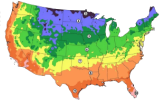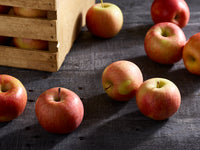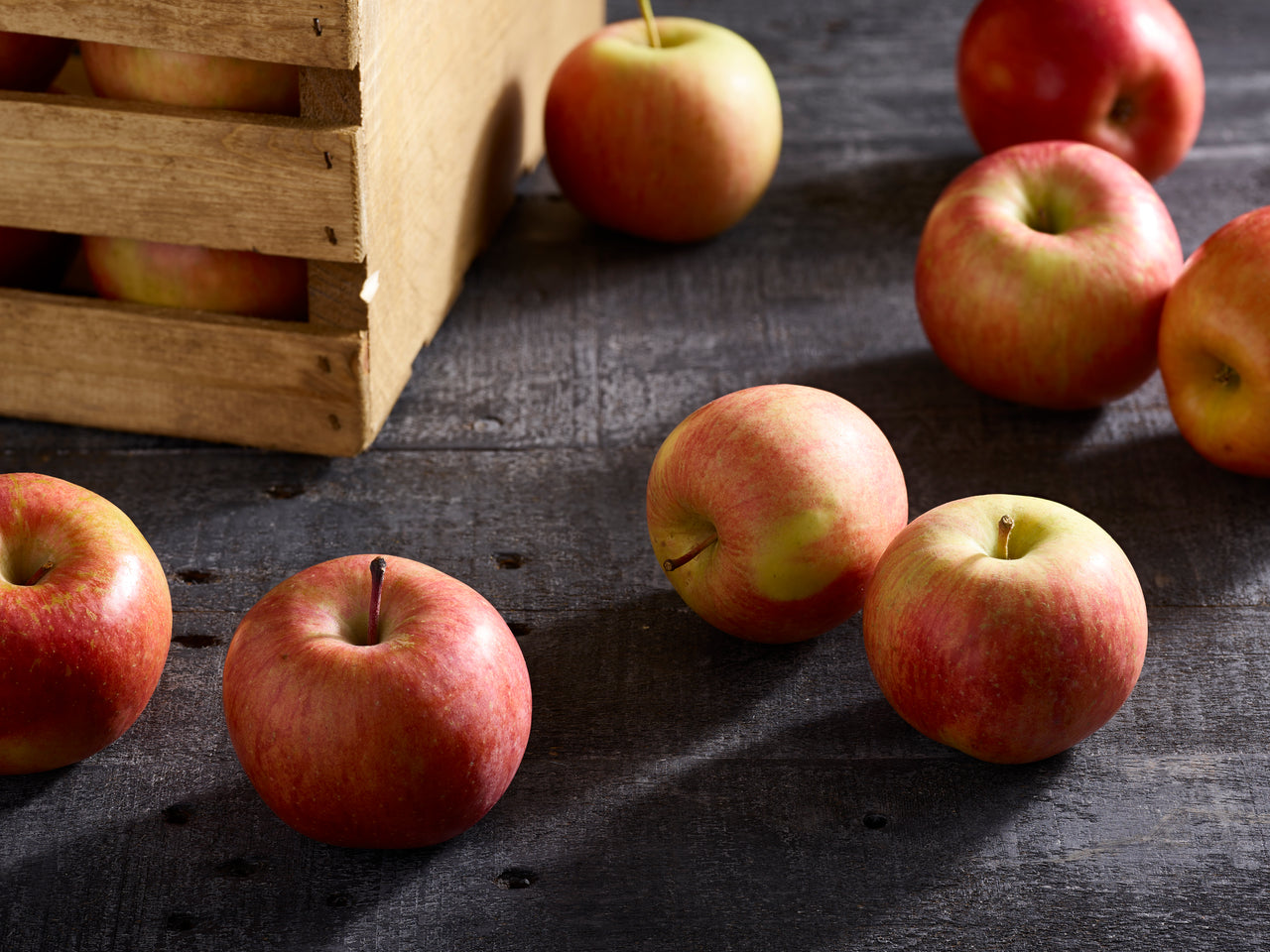Fuji Apple Tree
The Fuji apple originated in Japan and made its way to the United States in the 1960s, swiftly gaining popularity as California’s favorite apple. It offers a sweet, very crisp, and flavorful taste that apple enthusiasts adore. The skin is a dull reddish-orange color, occasionally displaying russeting. It ripens by mid-September, making it a delicious choice for apple lovers. Additionally, it serves as an excellent pollinizer for other apple varieties, promoting cross-pollination and fruit production. Its remarkable flavor, long shelf life, and adaptability to various growing conditions contributed to its popularity, particularly in California. Today, the Fuji apple is cultivated worldwide and is widely available in markets. With a low chilling requirement of less than 500 hours, the self-fruitful Fuji apple tree is suitable for USDA Zones 4-10.
Visit Paradise Nursery today. Whether you prefer in-store pickup or convenient delivery options, we provide the highest quality trees. Non-local customers can also order select items online for mail delivery. Purchase the Fuji apple tree from Paradise Nursery today and savor its delicious flavors.
Fruit and Tree Description
The fruit entices with its delectable qualities. It has a round to slightly conical shape and comes in a medium to large size. The skin is a dull reddish-orange color, sometimes featuring russeting. Bite into a Fuji apple, and you’ll experience a delightful combination of sweetness and a refreshing, crisp texture. The flavor is rich and complex, appealing to individuals of all ages. Furthermore, the Fuji apple is known for its exceptional keeping quality, ensuring prolonged enjoyment.
The Fuji apple tree adds beauty to any garden or orchard. It grows to a moderate size, making it suitable for various landscapes. The tree has an upright and spreading growth habit, with branches that bear abundant fruit. Its medium-sized, glossy leaves enhance its visual appeal. During spring, the Fuji apple tree displays clusters of stunning pink and white flowers, creating a captivating sight. As the tree matures, it develops a strong and sturdy structure, capable of withstanding environmental conditions.
Uses
The Fuji apple is a versatile fruit suitable for various purposes. Its crisp texture and sweet flavor make it ideal for fresh consumption, either as a standalone snack or in salads. When it comes to baking, the Fuji apple retains its shape and flavor, adding delightful sweetness to pies, tarts, and other baked goods. Moreover, its exceptional keeping quality allows for storage and enjoyment throughout the winter months. Additionally, the Fuji apple tree serves as a valuable pollenizer, facilitating successful pollination and increased fruit production for other apple varieties.
The size an apple tree grows depends on the space its given. Although apple trees can grow up to 30’, most homeowners want a high density backyard orchard with compact trees that are easily managed. Plant your trees about 10’ apart to maintain trees 10-15’ feet tall.
We carry two main forms: Standard and Semi-dwarf.
Standard trees have a single trunk with a canopy that sits well above the ground. These are great for walkways or other open areas.
Semi-dwarf are usually grafted onto dwarf rootstock and pruned to grow like a bush from an early age. Their canopies are very close to the ground which is great for not obstructing views, easier harvesting and are the usual go-to’s for planting in pots.
The main factors that impact growth are the amount of space, water & sunlight the apple tree receives.
Step One:
Dig a hole twice as wide and as deep as the root ball
Step Two:
Mix half of the soil that is dug out with the same amount of planting mix
Step Three:
Place the tree in the center of the hole with the top of the root ball level with the ground
Step Four:
Backfill with the amended soil
Step Five:
Use the rest of the dug up soil to create a berm around the tree
Step Six:
Spread planting mix over there soil inside the berm
Step Seven:
Top dress with fertilizer
Step Eight:
Flood the well with water to get it saturated
Sun Exposure:
- Apple trees require at least 5 hours of direct sunlight for proper growth and fruit production.
- Afternoon sun is much more intense than morning sun. Overheating without sufficient water can cause the leaves to natural cycle and chlorophyll to break down and eventually yellow or die. Depending on where you live, you may need afternoon protection.
- Highly reflective surfaces and heat traps like cinderblock walls, patios and fencing can greatly exacerbate heat stress.
- Cooling or adding shade to surrounding areas can help mitigate the effects of intense sun exposure. For example, use larger more tolerant trees like Mulberries, Figs and Pomegranate trees as natural shade by planting on the North side of apple trees.
Newly planted Apple trees require regular water during Spring thru Fall to establish. The frequency mainly depends on how hot it is. Therefore, you water more frequently (possibly every other day) during a heat wave in the summer than in the spring and fall. *Newly planted young apple trees require regular water during the spring thru fall growing season for healthy growth and fruit production. Irrigation frequency changes by the season. Begin watering weekly in the beginning of Spring once plants leaf out. Increase the frequency as the weather warms towards the Summer. Irrigate 2-3 times a week during the Spring and Summer, providing supplemental water during heat waves. If possible, spray water overhead and surrounding area to cool the area.
Are you watering with a hose or automatic irrigation system?
If you’re watering with a hose, you need to make sure the ground isn’t flat and that there is a berm (or water well) built up around the tree’s canopy so the water collects above the roots and doesn’t run off. Watering with a hose is the least initial setup cost but the most time consuming in the long run.
Types of Automatic Irrigation Systems:
There are also ways to automatically water your trees; Bubblers, sprinklers, and drips are the most common types of automatic irrigation systems. The duration a system should run depends on the emitters flow rate (GPM - gallons per minute). These irrigation systems help ensure consistent watering times and quantity and reduce operator error.
In order to fully saturate the soil around the tree’s roots, flood the watering well multiple times. Irrigation systems should be run long enough to saturate the soil depending on the flow rate.
Water Frequency:
Water frequency varies depending on seasonal weather conditions such as temperature, wind speed, humidity, soil type, and plant health. It’s important to know that sandier soils will dry faster, while clay holds more water and dries slower.
Some general guidelines include:
- Water newly planted trees 1-3 times per week during the Spring and Summer
- Increase frequency with higher temperatures and wind speeds
- Reduce frequency once temperatures drop in Winter
- Remember, lack of water, combined with high temps can result in the leaf's stomates (pores) to close causing the surface to get too hot and breakdown the chlorophyll turning the leaves yellow and/or die.
Quantity of Water:
The quantity of water should be enough to saturate the soil around the trees roots, then drain to field capacity. Clay soils retain more water than sandy/loamy soils. In general:
- Provide about 3-5 gallons of water for a 5 gallon size plant
- 12-15 gallons of water for a 15 gallon size plant
- 20-25 gallons of water for a 25 gallon size plant
- All this is dependent on soil type
Below are a few tips to save water and grow healthy plants
- Spread a few inches of mulch above the roots to reduce evaporation.
- Reduce frequency of water when weather cools down in the fall/winter. Consider turning irrigation systems off the in winter.
- Try to water during the coolest part of the day.
- Use drought tolerant plant varieties.
By following these watering instructions, you can help ensure that your apple trees receive the moisture they need to thrive and produce healthy, abundant fruit.
General Fertilizer Information
There are 3 main macronutrients that you’ll see on every bag or box of fertilizer; Nitrogen (N), Phosphorus (P), and Potassium (K) - NPK.
Nitrogen is largely responsible for foliage growth because its the main part of photosynthesis and the green color we see in leaves. Therefore, yellow leaves can be associated with lack of nitrogen.
Phosphorus helps root growth as well as flowers and fruits, and Potassium helps the overall function of the tree and supports the plants vitality as well as ability to fight infections. The numbers shown, for example 8-4-4, represent the percentages of said nutrients that are available in the fertilizer. 8% Nitrogen, 4% Phosphorus and 4% Potassium.
Phosphorus and Potassium mainly help with flower and fruit development, therefore providing a fertilizer formulated with more phosphorus and potassium than nitrogen, prior to the plant flowering, can increase yields.
There are also 7 essential plant nutrients known as micronutrients; Boron (B), Zinc (Zn), Manganese (Mn), Iron (Fe), Calcium (Ca), Magnesium (Mg), Copper (Cu), Molybdenum (Mo), and Chlorine (Cl). They make up less than 1% of the total dry weight of plants, but are also vitally important to the trees overall health.
When to Fertilize
Spring is the most important time to fertilize. Apply a fertilizer with more nitrogen to promote growth.
Our 8-4-4 is an example of a complete fertilizer with more nitrogen to promote growth and fruit production. Apply every 3 months. spring through fall, starting in March.
Apply our 3-12-12 Harvest Booster in the winter for deciduous trees to promote spring blossoms. Supplement our Harvest Booster in the spring for Citrus Trees.
If you’re noticing any more deficiencies, even after fertilizing, you may need to put in additional micro-nutrients like Magnesium, Calcium and Iron. Keep in mind that your fertilizing schedule will depend on your tree's seasonal cycle more than anything.
How Much Fertilizer To Use
- Apply 1 cup (150 grams) for every 1” of diameter of the trunk or 15 gallon size.
- Apply 2 cups (300 grams) for every 2’ diameter of trunk or 25 gallon size.
Maintain that 1:1 ratio as the tree(s) mature.
Instructions on Pruning Apple Trees:
Timing of Pruning:
- Prune apple trees during the dormant season, typically in late winter to early spring before new growth begins.
- Avoid pruning apple trees during periods of active growth or in late fall, as this may stimulate new growth that is vulnerable to winter damage.
Tools and Equipment:
- Use sharp, clean pruning tools, such as hand pruners, loppers, and pruning saws, to make clean cuts and minimize the risk of disease transmission.
- Disinfect pruning tools between each tree to prevent the spread of pathogens.
Objectives of Pruning:
- Remove dead, diseased, or damaged branches to improve the overall health and appearance of the apple tree.
- Thin out crowded or crossing branches to improve air circulation and sunlight penetration within the canopy.
- Shape the tree to promote an open, well-structured canopy that allows for even fruit production and easy harvesting.
Pruning Techniques:
- Begin by removing any dead, diseased, or broken branches, making clean cuts just outside the branch collar (the swollen area where the branch meets the trunk).
- Thin out excessive growth by selectively removing crowded or crossing branches to allow for better light and air distribution.
- Use heading cuts to prune back overly vigorous branches to encourage branching and promote fruiting wood formation.
- Consider the fruiting habit of the apple tree when pruning, as some apple trees produce fruit on spurs (short, stubby branches) while others bear fruit on new growth.
Training Young Trees:
- Train young apple trees by selectively pruning to establish a strong, well-balanced framework of scaffold branches.
- Encourage outward growth by pruning back inward-growing branches and removing competing leaders to maintain a central leader or open-center shape.
Considerations for Different Apple Tree Varieties:
- Different apple tree varieties may have specific pruning requirements based on their growth habits, fruiting patterns, and desired form.
- Research the specific pruning needs of the apple tree varieties you are growing and tailor your pruning practices accordingly.
Monitoring and Maintenance:
- Monitor the apple tree throughout the growing season for any additional pruning needs, such as removing water sprouts or suckers that may develop.
- Regularly inspect the tree for signs of pests, diseases, or other issues that may require pruning intervention.
By following these pruning instructions, you can help maintain the health, productivity, and appearance of your apple trees for optimal growth and fruit production.
Instructions on Pest Management for Apple Trees:
Monitor for Pests:
- Regularly inspect apple trees for signs of pest infestation, such as chewed leaves, distorted growth, or the presence of insects or larvae.
- Keep an eye out for common apple tree pests, including aphids, scale insects, mites, caterpillars, and fruit flies.
Cultural Practices:
- Maintain good cultural practices, such as proper pruning, watering, and fertilizing, to promote healthy, resilient apple trees that are better able to withstand pest attacks.
- Remove and destroy any fallen fruit, leaves, or other plant debris that may harbor pests or disease pathogens.
Natural Predators:
- Encourage natural predators of pests, such as ladybugs, lacewings, and predatory wasps, by providing habitat and avoiding the use of broad-spectrum pesticides that may harm beneficial insects.
- Plant flowering plants nearby to attract pollinators and beneficial insects that help control pest populations.
Physical Barriers:
- Install physical barriers, such as tree wraps or trunk guards, to protect apple trees from crawling pests like ants and rodents.
- Use floating row covers or netting to exclude flying insects, birds, and other pests from accessing apple trees.
Biological Control:
- Consider using biological control methods, such as releasing beneficial nematodes or predatory insects, to target specific pests while minimizing harm to non-target organisms.
- Introduce parasitic wasps, predatory mites, or other natural enemies of pest insects to help control populations without the need for chemical pesticides.
Integrated Pest Management (IPM):
- Implement an integrated pest management (IPM) approach that combines multiple pest control strategies, including cultural, biological, physical, and chemical methods, to effectively manage pest populations while minimizing environmental impact.
- Monitor pest populations regularly and use thresholds to determine when intervention is necessary, prioritizing the use of non-chemical control methods whenever possible.
Selective Pesticide Use:
- Use chemical pesticides as a last resort and only when non-chemical methods have proven ineffective or when pest populations exceed acceptable thresholds.
- Selectively choose pesticides that are least harmful to beneficial insects, pollinators, and the environment, and follow label instructions carefully to minimize risks to human health and the ecosystem.
By following these pest management practices, you can help protect your apple trees from pest damage while promoting a healthy and sustainable orchard ecosystem.




